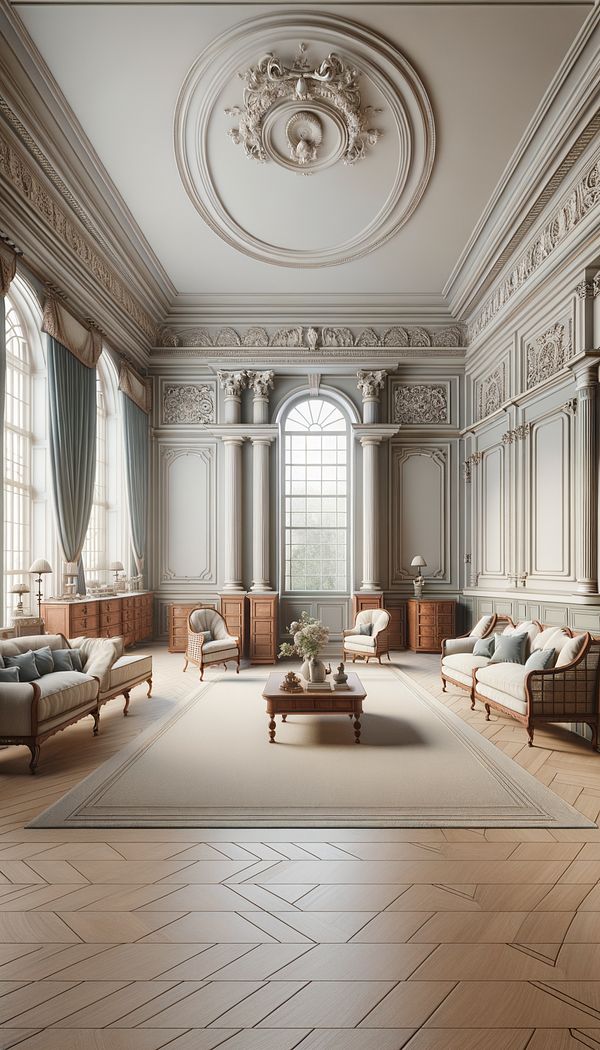What is Georgian?
Georgian architecture and interiors denote the styles that were popular in Britain during the reigns of the first four Georges, from 1714 to 1830.
Description
Georgian architecture and interiors are celebrated for their refined elegance, symmetry, and proportion, embodying the aesthetic values of the Enlightenment. This period saw a focus on harmony and clarity, with influences from ancient Rome and Greece, as well as from contemporary European movements. Essentially, Georgian design is characterized by its emphasis on order, the regularity of layout, and an adherence to classical rules of composition.
Interiors during the Georgian period featured balanced room layouts with a central axis, high ceilings, and sash windows that let in natural light. Walls were often adorned with decorative panels, intricate plasterwork, and a harmonious palette of soft, muted colors that contributed to the overall sense of elegance and grace. Furniture in Georgian interiors followed the same principles of symmetry and proportion, with pieces often crafted from mahogany, walnut, and oak, showcasing fine woodworking skills and attention to detail.
Over time, Georgian design evolved, incorporating more elaborate decorative elements and richer color schemes, especially in the later stages. This period also marked the beginning of the landscape gardening movement, where the principles of Georgian design were applied to the arranging and styling of outdoor spaces, creating a seamless transition between interior and external environments.
Usage
In contemporary contexts, Georgian design principles are often incorporated into the restoration of historical homes or in creating new spaces that seek to emulate the elegance and sophistication of this period. Designers may use Georgian-style furniture, symmetrical layouts, and a palette inspired by the 18th and early 19th centuries to achieve a sense of timeless elegance. Additionally, Georgian principles of landscape design continue to influence garden layouts, favoring structured, symmetric designs and the strategic use of greenery to enhance the harmony between buildings and their surroundings.
FAQs
-
How can I incorporate Georgian design elements into a modern home?
Incorporate Georgian elements into a modern home by using symmetrical layouts, opting for furniture with clean lines and fine craftsmanship, and choosing a color palette of soft, muted colors. Incorporating architectural details like decorative moldings and sash windows can also help blend Georgian elegance with modern aesthetics.
-
Are there any particular materials or finishes that are characteristic of Georgian interiors?
Georgian interiors often featured materials such as mahogany, walnut, and oak for furniture. Walls were adorned with decorative plasterwork and panels, and flooring options included polished wooden floors and patterned carpets. Soft muted colors and sometimes richer tones in wall paints or fabrics were characteristic of the period.
-
What is the difference between early and late Georgian design?
Early Georgian design focused on symmetry, proportion, and adherence to classical architectural principles, with simpler decorative elements. As the period progressed, late Georgian design incorporated more elaborate decorations, richer color schemes, and began exploring the romantic aspects of design, although it maintained its core principles of symmetry and order.
Practical Application
To successfully incorporate Georgian elements into your interior design practice, begin by understanding the principles of symmetry, order, and proportion that define this style. Whether working on modern or historical projects, strive to balance contemporary needs with Georgian aesthetics by choosing furniture and decorative elements that reflect the elegance and craftsmanship of the period. Additionally, consider how natural light and landscape design can enhance the overall harmony between indoor and outdoor spaces.
-
Architectural Elements199 articles
-
Design Styles478 articles
-
Furniture Types599 articles
-
Decorative Techniques322 articles
-
Wall Treatments & Finishes157 articles
-
Classic StyleClassic Style is a timeless, elegant, and harmonious design philosophy that emphasizes symmetry, sophistication, and functionality.
-
AnthemionAnthemion is a design motif consisting of a radial cluster of palm leaves or floral patterns.
-
TapestryA heavy textile handwoven with rich, colorful designs or scenes, often used as a wall hanging.
-
Gallery WallA gallery wall is a curated display of photographs, artwork, or objects on a wall.
-
Tea TableA small table designed for serving or enjoying tea.
